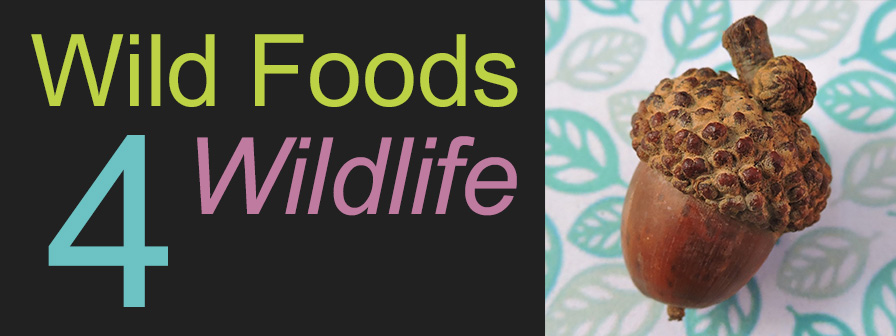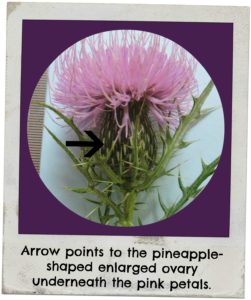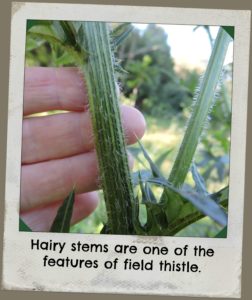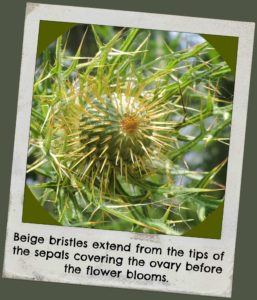Name: Field Thistle
Botanical Name: Cirsium discolor
Form: wildflower
Parts Used: seeds
Citation: Guenther, K. (2017, January 12) Field thistle as wildlife food [Web log post.] Retrieved: readers supply the date, from http://wildfoods4wildlife.com
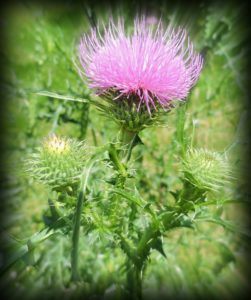 Getting Started
Getting Started
Both Circium spp. and Carduus spp. seeds rank #41 on our Super Seeds list.
You have to really love your rehabber to collect thistle seed. Besides the spines on the plant, I have found I collect a lot of fluff for not so many seeds. But thistle is an easy to identify genus and an easy to find plant. And for goldfinch, well, it is one of their favorite foods.
Many folks can recognize the spiny thistle plants of summer field and roadside. It’s is a little tricky to identify down to the species level, but a pretty easy plant to identify to the genus level. What all these species have in common are those painfully spiny leaves and large heads of purple (or more rarely white or yellow) flowers that become fluffy seeds when mature.
Asteraceae (Aster Family)
Carduoideae (Thistle Subfamily)
Cynereae (Thistle tribe)
Circium (Genus)
OR
Carduus (Genus)
Some people may confuse thistle with knapweeds (Centaurea genus) of the same thistle subfamily or with teasels which are a different family of plants altogether. Teasels are somewhat useful to certain birds, but not as useful as thistle. Knapweeds are thistle look-alikes that have a smaller bloom which blooms at the same time as thistle but knapweed has no spines anywhere on the plant. Knapweed seeds are also eaten by birds.
In Virginia, there are many native thistle species, but as often is the case, the relative likelihood of encountering a non-native species is high. Wildlife probably prefer native species: it would stand to reason. Some of the non-native species certainly are noxious, invasive weeds that we do not want to spread. The risk of spreading non-native seeds into the larger ecosystem can be reduced if you clean the collected seed of its pappus “parachute” hairs.
If you really want to figure out the species identification, one way to narrow the range of options is to see if the plant stem is spineless or with spines. Natives in Virginia typically do not have spines on the stem.
| Common name | Virginia Cirsium species | Origin | Spines on Stems? | Rare Plant Status |
| tall thistle | C. altissimum | native | no | Globally secure, critically imperiled in Virginia |
| Canada thistle | C. arvense | non-native | no | not rare |
| soft thistle | C. carolinianum | native | no | Globally secure, critically imperiled in Virginia |
| field thistle | C. discolor | native | no- but has hairs | not rare |
| yellow thistle | C. horridulum | native | no | yes, in some states (not Virginia) |
| swamp thistle | C. muticum | native | no | yes, in some states (not Virginia) |
| Nuttall’s thistle | C. nuttallii | native | no | Globally secure, may already be extirpated in Virginia |
| pasture thistle | C. pumilum | native | no | not rare |
| sandhill thistle | C. repandum | native | yes | Globally secure, may already be extirpated in Virginia |
| Virginia thistle | C. virginianum | native | no | Globally vulnerable, imperiled in Virginia |
| bull thistle | C. vulgare | non-native | yes | not rare |

Key Features to Look For
In addition to the identification guide of your choice, here are a couple of features you should see on field thistle:
- Very tall, well over one’s head in height
- Has hairs, but not spines, along main stem
- Very narrow leaves where the indentations (sinuses) of the leaf almost to touch the rib
- Pink round flower head looks like it has a small green pineapple directly underneath it
- Sharp spines on all leaf lobe tips
Risks
No risks associated with animals eating seeds.
About this Species
It may not be important from a birdseed collecting point of view to identify any given thistle to the species level, unless you are very concerned about only collecting native thistles. But this native species—field thistle— really stands out as a very tall species, and towers over my head at about 8 feet.
Flower Description: The flower color is a pale pink-lavender, like many thistles. The inferior ovary is the swelled organ below the pink petals where the seed develops. If viewed from the side it looks a little like a green pineapple (to me). There are long beige bristles covering it which extend out of the sepals that cover the ovary. The topmost leaves of the stem also curl upward and hug the ovary.
Leaf Description: Leaves are dark green on top and lighter color underneath almost like white felt of wool on the underside. The leaves are narrow and deeply incised, with spines on the end of each leaf lobe.
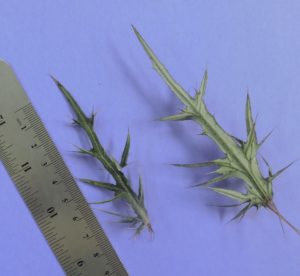
Seed/ Fruit Size: The cleaned seed itself (no pappus) is about 3/16 inch wide (2 mm) and 13/32 inch long (4 mm) and reminds me of a banana pepper in shape. The white pappus “parachute”or “hair”, is about ¾ inch long (20+ mm).
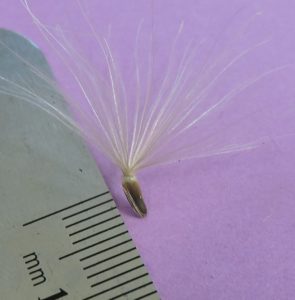
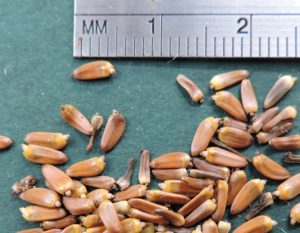
Harvest
| Jan | Feb | Mar | Apr | May | Jun | Jul | Aug | Sep | Oct | Nov | Dec | ||||||||||||||
|---|---|---|---|---|---|---|---|---|---|---|---|---|---|---|---|---|---|---|---|---|---|---|---|---|---|
| winter | winter | late winter | early spring | spring | late spring | early summer | summer | late summer | early fall | fall | late fall | ||||||||||||||
| seeds | x | x | x | ||||||||||||||||||||||
When to Harvest: Shortly after flowering, the seeds mature and disperse to the wind on fluffy parachutes, like dandelion does. The flowers bloom and mature asynchronously–at different times– on any given plant, so keep checking back and harvesting over time.
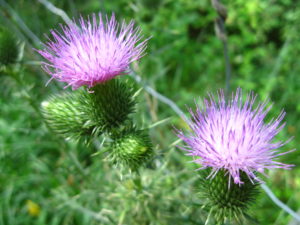
Harvesting Seed
Wait until the seed head opens to reveal the white silky “tails” on the seeds. By now, the plant may be browning and dry.
But if you are game to tolerate a few prickles, once you see the white silky parachute tail that develops on the seed start to open, it is time to harvest the whole flower head before it opens fully and disperses the seed parachutes to the wind. If you find a stand of thistle in bloom, come back each day for a week and harvest the mature flower heads as they open. Cut or break off the mature flower head and place in a brown paper sack. Store inside so the flower heads will dry from any moisture and continue to ripen for a couple of more days or a week.
After dry, to clean the seed out of the flower head, hold the flower head (now brown, dried sepals) in one rubber-gloved hand (to avoid the prickles)and pinch the fluffy pappus (white feathery silky fluff) with your other hand and pull it straight out and place it in a large bowl. Hopefully you will see the seed pull out with the pappus.
Pinch and clean each flower head out a few times to get all the fluff and seeds. If you pull out the pappus and there is no seed attached, then you can break the flower head in half after removing all the fluff and see if you can scrape out the seed that might still be lodged in the ovary.
Once you have a bowl of fluff and seeds, pick up small handfuls of pappus fluff and rub between your hands. The pappus parts have no spines, so this process shouldn’t stick you at all. The pappus will bunch up as you rub and most of the seeds will fall out. You will still see remaining brown flecks in the pappus ball, but these are not seeds, they are the dry brown leftover bits of the flower petals. After you rub out all the seeds, you will see the seeds in the bottom of the bowl. There will not be as many as you hoped for.
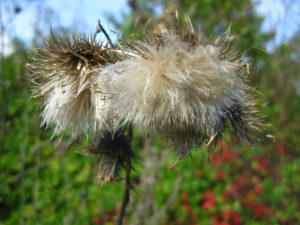
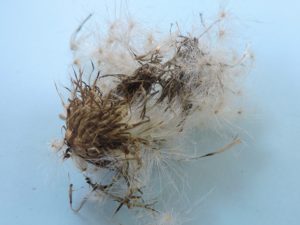
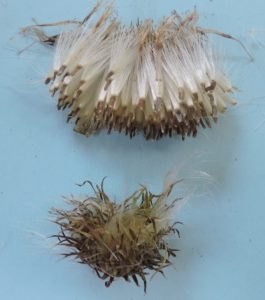
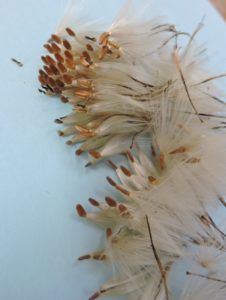
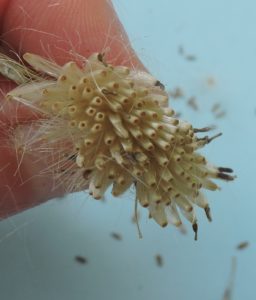
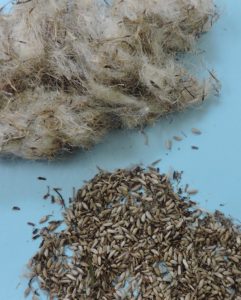
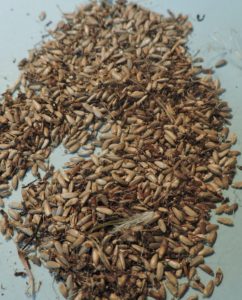
Other Thistle Species
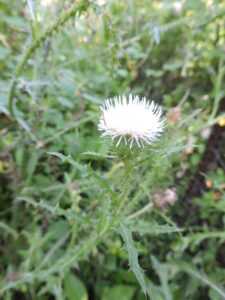
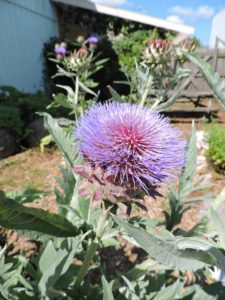
Rare Species in Virginia
Do you live in one of these Virginia counties? If so, be aware that there are some species near you that may be threatened or endangered. Do more research to make sure you are identifying your target species correctly and not harvesting a threatened species!
| County in Virginia | Species | Alert |
| Arlington | tall thistle | Globally secure, critically imperiled in Virginia |
| Botetourt | tall thistle | Globally secure, critically imperiled in Virginia |
| Brunswick | Virginia thistle | Globally vulnerable, imperiled in Virginia |
| Charles City | Virginia thistle | Globally vulnerable, imperiled in Virginia |
| Chesterfield | Virginia thistle | Globally vulnerable, imperiled in Virginia |
| Dinwiddie | Virginia thistle | Globally vulnerable, imperiled in Virginia |
| Fairfax | tall thistle | Globally secure, critically imperiled in Virginia |
| Fairfax | soft thistle | Globally secure, critically imperiled in Virginia |
| Franklin | soft thistle | Globally secure, critically imperiled in Virginia |
| Frederick | tall thistle | Globally secure, critically imperiled in Virginia |
| Greensville | Virginia thistle | Globally vulnerable, imperiled in Virginia |
| Halifax | soft thistle | Globally secure, critically imperiled in Virginia |
| Henrico | Virginia thistle | Globally vulnerable, imperiled in Virginia |
| Henrico | tall thistle | Globally secure, critically imperiled in Virginia |
| Prince George | Virginia thistle | Globally vulnerable, imperiled in Virginia |
| Shenandoah | tall thistle | Globally secure, critically imperiled in Virginia |
| Southampton | Nuttall’s thistle | Globally secure, may already be extirpated in Virginia |
| Southampton | sandhill thistle | Globally secure, may already be extirpated in Virginia |
| Sussex | Virginia thistle | Globally vulnerable, imperiled in Virginia |
| Virginia Beach | Nuttall’s thistle | Globally secure, may already be extirpated in Virginia |
Feed Field Thistle to:
thistle | (Carduus spp.) | seeds |
|---|---|---|
Deer, White-tailed | Odocoileus virginianus |
|
Mouse, Common White-footed | Peromyscus leucopus |
|
Mouse, Deer | Peromyscus maniculatus nubiterre |
|
Vole, Pine | Microtus pinetorum |
|
Vole, Red-backed | Myodes spp., Clethrionomys spp. |
|
Voles, various spp. | various species |
|
Goldfinch, American | Carduelis tristis | strong preference |
Bunting, Indigo | Passerina cyanea |
|
Finch, House | Carpodacus mexicanus |
|
Junco, Dark-eyed | Junco hyemalis |
|
Pipit, American | Anthus rubescens |
|
Redpoll, Common | Carduelis flammea |
|
Siskin, Pine | Carduelis pinus |
|
Book References:
Martin, A.C., Zim, H.S., Nelson, A.L. (1951). American Wildlife and Plants: A Guide to Wildlife Food Habits. New York: Dover Publications.
Scott, M. (2013). Songbird Diet Index. National Wildlife Rehabilitators Association, St. Cloud, MN.
Townsend, J. F. (2015, April) Rare Plants Natural Heritage Technical Report 15-10. (Unpublished Report) Richmond, Virginia: Virginia Department of Conservation and Recreation, Division of Natural Heritage.
On-line Resources:
USDA, NRCS. 2015. The PLANTS Database (http://plants.usda.gov, 4 January 2016). National Plant Data Team, Greensboro, NC 27401-4901 USA.
Virginia Botanical Associates. (Accessed January 2016). Digital Atlas of the Virginia Flora (http://www.vaplantatlas.org). c/o Virginia Botanical Associates, Blacksburg.
Zouhar, Kris. 2002. Cirsium vulgare. In: Fire Effects Information System, Online].
U.S. Department of Agriculture, Forest Service, Rocky Mountain Research Station, Fire Sciences Laboratory (Producer).
Available: http://www.fs.fed.us/database/feis/plants/forb/cirvul/all.html [2016, December 4].
Zouhar, Kris 2001. Cirsium arvense. In: Fire Effects Information System, [Online].
U.S. Department of Agriculture, Forest Service, Rocky Mountain Research Station, Fire Sciences Laboratory (Producer).
Available: http://www.fs.fed.us/database/feis/plants/forb/cirvul/all.html [2016, December 4].
